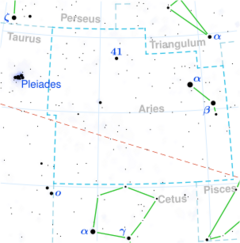Astronomy:Mu Arietis
| Observation data Equinox J2000.0]] (ICRS) | |
|---|---|
| Constellation | Aries |
| Right ascension | 02h 42m 21.93980s[1] |
| Declination | +20° 00′ 41.2612″[1] |
| Apparent magnitude (V) | 5.74[2] (6.38/8.38/6.72/12.2)[3] |
| Characteristics | |
| Spectral type | A0 Vp + F2 V + A1 V[3] |
| U−B color index | –0.03[4] |
| B−V color index | –0.02[4] |
| Astrometry | |
| Radial velocity (Rv) | –6.0[5] km/s |
| Proper motion (μ) | RA: +27.68[1] mas/yr Dec.: –47.64[1] mas/yr |
| Parallax (π) | 9.64 ± 0.88[1] mas |
| Distance | 340 ± 30 ly (104 ± 9 pc) |
| Absolute magnitude (MV) | +0.41[6] |
| Orbit[7] | |
| Period (P) | 8.845 ± 0.046 yr |
| Semi-major axis (a) | 0.0563 ± 0.0008″ |
| Eccentricity (e) | 0.337 ± 0.023 |
| Inclination (i) | 71.2 ± 1.1° |
| Longitude of the node (Ω) | 101.0 ± 1.0° |
| Periastron epoch (T) | B 1981.099 ± 0.063 |
| Argument of periastron (ω) (secondary) | 92.3 ± 1.7° |
| Details | |
| Mass | 3.4 ± 1.7 (Aa) / 2.1 ± 1.7 (Ab)[7] M☉ |
| Luminosity | 71.7[6] L☉ |
| Rotational velocity (v sin i) | 175[8] km/s |
| Other designations | |
μ Ari, 34 Arietis, BD+19 403, HD 16811, HIP 12640, HR 793, SAO 93062.[9] | |
| Database references | |
| SIMBAD | data |
Mu Arietis, Latinized from μ Arietis, is the Bayer designation for a star system in the northern constellation of Aries. It is approximately 340 light-years (100 parsecs) distant from Earth, give or take a 30 light-year margin of error, and has a combined apparent visual magnitude of 5.74.[2] According to the Bortle Dark-Sky Scale, this means it is faintly visible to the naked eye from dark suburban skies.
At the heart of this system is a close orbiting pair consisting of a magnitude 6.38 A-type main sequence star with a stellar classification of A0 Vp and a magnitude 8.38 F-type main sequence companion with a classification of F2 V. These two components have an angular separation of 0.04 arcseconds. A third component, consisting of a magnitude 6.72 star with a classification of A1 V, is orbiting the inner pair with a period of 8.845 years and an eccentricity of 0.34. A smaller fourth component, at an angular separation of 19.1 arcseconds, has a magnitude of 12.2.[3]
References
- ↑ 1.0 1.1 1.2 1.3 1.4 van Leeuwen, F. (November 2007), "Validation of the new Hipparcos reduction", Astronomy and Astrophysics 474 (2): 653–664, doi:10.1051/0004-6361:20078357, Bibcode: 2007A&A...474..653V.
- ↑ 2.0 2.1 Oja, T. (August 1991). "UBV photometry of stars whose positions are accurately known. VI". Astronomy and Astrophysics Supplement Series 89 (2): 415–419. Bibcode: 1991A&AS...89..415O.
- ↑ 3.0 3.1 3.2 Eggleton, P. P.; Tokovinin, A. A. (September 2008), "A catalogue of multiplicity among bright stellar systems", Monthly Notices of the Royal Astronomical Society 389 (2): 869–879, doi:10.1111/j.1365-2966.2008.13596.x, Bibcode: 2008MNRAS.389..869E.
- ↑ 4.0 4.1 Osawa, K.; Hata, S. (1960), "Three colour photometry of B8-A2 stars.", Annals of the Tokyo Astronomical Observatory 6: 148, Bibcode: 1960AnTok...6..148O.
- ↑ Palmer, D. R. et al. (1968), "The radial velocities spectral types and projected rotational velocities of 633 bright northern A stars", Royal Observatory Bulletin 135: 385, Bibcode: 1968RGOB..135..385P.
- ↑ 6.0 6.1 Anderson, E.; Francis, Ch. (2012), "XHIP: An extended hipparcos compilation", Astronomy Letters 38 (5): 331, doi:10.1134/S1063773712050015, Bibcode: 2012AstL...38..331A.
- ↑ 7.0 7.1 Mason, Brian D. (1997). "Binary Star Orbits from Speckle Interferometry. XI. Orbits of Twelve Lunar Occultation Systems". The Astronomical Journal 114: 808. doi:10.1086/118514. Bibcode: 1997AJ....114..808M.
- ↑ Royer, F.; Zorec, J.; Gómez, A. E. (February 2007), "Rotational velocities of A-type stars. III. Velocity distributions", Astronomy and Astrophysics 463 (2): 671–682, doi:10.1051/0004-6361:20065224, Bibcode: 2007A&A...463..671R.
- ↑ "mu. Ari". SIMBAD. Centre de données astronomiques de Strasbourg. http://simbad.u-strasbg.fr/simbad/sim-basic?Ident=mu.+Ari.
External links
 |


